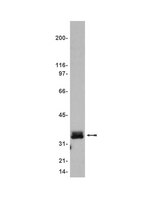A conserved motif in the ITK PH-domain is required for phosphoinositide binding and TCR signaling but dispensable for adaptor protein interactions.
Hirve, N; Levytskyy, RM; Rigaud, S; Guimond, DM; Zal, T; Sauer, K; Tsoukas, CD
PloS one
7
e45158
2012
Show Abstract
Binding of the membrane phospholipid phosphatidylinositol 3,4,5-trisphosphate (PIP(3)) to the Pleckstrin Homology (PH) domain of the Tec family protein tyrosine kinase, Inducible T cell Kinase (ITK), is critical for the recruitment of the kinase to the plasma membrane and its co-localization with the TCR-CD3 molecular complex. Three aromatic residues, termed the FYF motif, located in the inner walls of the phospholipid-binding pocket of the ITK PH domain, are conserved in the PH domains of all Tec kinases, but not in other PH-domain containing proteins, suggesting an important function of the FYF motif in the Tec kinase family. However, the biological significance of the FYF amino acid motif in the ITK-PH domain is unknown. To elucidate it, we have tested the effects of a FYF triple mutant (F26S, Y90F, F92S), henceforth termed FYF-ITK mutant, on ITK function. We found that FYF triple mutation inhibits the TCR-induced production of IL-4 by impairing ITK binding to PIP(3), reducing ITK membrane recruitment, inducing conformational changes at the T cell-APC contact site, and compromising phosphorylation of ITK and subsequent phosphorylation of PLCγ(1). Interestingly, however, the FYF motif is dispensable for the interaction of ITK with two of its signaling partners, SLP-76 and LAT. Thus, the FYF mutation uncouples PIP(3)-mediated ITK membrane recruitment from the interactions of the kinase with key components of the TCR signalosome and abrogates ITK function in T cells. | | 23028816
 |
LAT: the ZAP-70 tyrosine kinase substrate that links T cell receptor to cellular activation.
Zhang, W, et al.
Cell, 92: 83-92 (1998)
1998
Show Abstract
Despite extensive study, several of the major components involved in T cell receptor-mediated signaling remain unidentified. Here we report the cloning of the cDNA for a highly tyrosine-phosphorylated 36-38 kDa protein, previously characterized by its association with Grb2, phospholipase C-gamma1, and the p85 subunit of phosphoinositide 3-kinase. Deduced amino acid sequence identifies a novel integral membrane protein containing multiple potential tyrosine phosphorylation sites. We show that this protein is phosphorylated by ZAP-70/Syk protein tyrosine kinases leading to recruitment of multiple signaling molecules. Its function is demonstrated by inhibition of T cell activation following overexpression of a mutant form lacking critical tyrosine residues. Therefore, we propose to name the molecule LAT-linker for activation of T cells. | Immunoblotting (Western) | 9489702
 |









